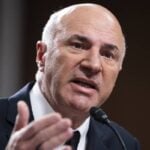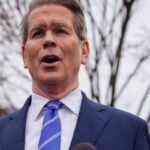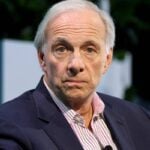We adhere to strict standards of editorial integrity to help you make decisions with confidence. Some or all links contained within this article are paid links.
With the annual price of attending Brown University approaching six figures, sophomore Alex Shieh wanted to know where all that money was going. In particular, he wanted to know what the school’s thousands of non-faculty employees were doing each day. So, he sent them a DOGE-style email asking that exact question.
Now, he’s facing disciplinary action.
“The inspiration for this is the rising cost of tuition,” Shieh told Fox News in a story published April 4. “Next year, it’s set to be $93,064 to go to Brown.”
Don’t miss
- I’m 49 years old and have nothing saved for retirement — what should I do? Don’t panic. Here are 6 of the easiest ways you can catch up (and fast)
- Robert Kiyosaki warns of a ‘Greater Depression’ coming to the US — with millions of Americans going poor. But he says these 2 ‘easy-money’ assets will bring in ‘great wealth’. How to get in now
- Want an extra $1,300,000 when you retire? Dave Ramsey says this 7-step plan ‘works every single time’ to kill debt, get rich in America — and that ‘anyone’ can do it
This figure reflects the direct costs associated with attending Brown for one year, as shown on the school’s website, including tuition, fees and allowances for food and housing. First-time students are billed an extra $100. Brown’s undergraduate enrollment stands at 7,272.
To illustrate what he saw as administrative bloat, Shieh compiled a database of 3,805 non-faculty employees, according to Fox News. In an email similar to those sent by Elon Musk’s Department of Government Efficiency to federal workers, he asked them: “What do you do all day?”
Shieh says only 20 people responded — some with profane replies — and soon after the university moved to discipline him.
"Brown is charging me for misrepresentation — for saying I am affiliated with The Brown Spectator," Shieh said in a follow-up story published by Fox News on April 30. In his emails, Shieh identified himself as a journalist for The Spectator — a long-inactive student journal that Shieh claims he and other students are trying to bring back.
“Brown is also charging me for violating their IT policies for publishing Brown employee data,” Shieh said. A website was created identifying what was deemed to be wasteful spending at Brown, and the names and titles of employees were published. Shieh insisted to the Brown Daily Herald all of the information was publicly available.
Brown University, however, expressed a different view.
“In spite of what has been reported publicly framing this as a free speech issue, it absolutely is not,” a university spokesperson told Fox News. “At the center of Brown’s review are questions focused on whether improper use of non-public Brown data, non-public data systems and/or targeting of individual employees violated law or policy.”
Whether or not you agree Shieh’s approach was an appropriate way to investigate wastefulness, it’s an issue many of us deal with in our everyday lives, including in our personal finances.
Here are three simple ways to cut waste in your own life in 2025.
1. Stop overpaying for car insurance
Car insurance is a major recurring expense, and many people overpay without realizing it. According to Forbes, the average cost of full-coverage car insurance is $2,149 per year (or $179 per month).
However, rates can vary widely depending on your state, driving history and vehicle type, and you could be paying more than necessary.
By using OfficialCarInsurance.com, you can easily compare quotes from multiple insurers, such as Progressive, Allstate and GEICO, to ensure you’re getting the best deal.
In just two minutes, you could find rates as low as $29 per month.
2. Stop wasting money on bank fees
Bank fees can quietly drain your finances over time. In reality, many traditional banks will issue a charge if you don’t maintain a minimum balance, along with other actions such as overdrafting.
Online banks, on the other hand, typically offer lower fees (or none at all) since they don’t have the same overhead costs as brick-and-mortar institutions.
For example, you can open a high-yield checking and savings account with SoFi and earn up to 3.80% APY Plus, SoFi charges no account, monthly or overdraft fees.
The best part? You can get up to $300 when you sign up with SoFi and set up a direct deposit.
Read more: You don’t have to be a millionaire to gain access to this $1B private real estate fund. In fact, you can get started with as little as $10 — here’s how
3. Let your spare change grow
One of the easiest ways to cut financial waste is by putting your spare change to work instead of letting it sit idle. That’s where micro-investing apps like Acorns come in.
When you make a purchase on your credit or debit card, Acorns automatically rounds up the price to the nearest dollar and invests the difference — the coins that would wind up in your pocket if you were paying cash — into a diversified portfolio of ETFs.
Buy a coffee for $3.40? The app rounds it up to $4 and invests the extra $0.60. Over time, those small amounts can add up — especially if you’re consistently spending and saving.
It’s a simple, set-it-and-forget-it way to build wealth from money you might not even miss — and, if you sign up today, Acorns will add a $20 bonus to help you begin your investment journey.
What to read next
- Financial aid only funds about 27% of US college expenses — but savvy parents are using this 3-minute move to cover 100% of those costs
- Here are 5 ‘must have’ items that Americans (almost) always overpay for — and very quickly regret. How many are hurting you?
- How much cash do you plan to keep on hand after you retire? Here are 3 of the biggest reasons you’ll need a substantial stash of savings in retirement
- This is how American car dealers use the ‘4-square method’ to make big profits off you — and how you can ensure you pay a fair price for all your vehicle costs
Money doesn’t have to be complicated — sign up for the free Moneywise newsletter for actionable finance tips and news you can use. Join now.
This article provides information only and should not be construed as advice. It is provided without warranty of any kind.





